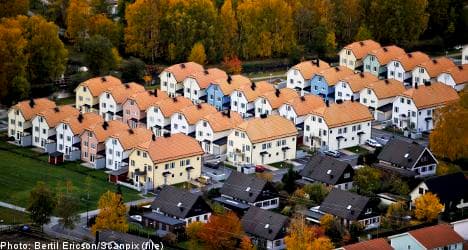Billions more needed to rid housing shortage

A national government agency has estimated that another 19 billion kronor ($2.81 billion) are needed to "build away" Sweden's housing shortage every year.
Although 35,000 new homes are needed every year to address the shortage, but only 28,000 are being built, according to the National Housing Credit Guarantee Board's (Statens Bostadskreditnämnd, BKN) report "What would it cost to build out the housing shortage?" published on Wednesday.
The board is a national government agency under the Ministry of Finance. It publishes a market report three times a year in February, May and October.
The board's estimate is based on a return to normal interest rate and 20 percent lower housing prices. Currently, about 115 billion kronor are invested in per year in homes.
Soaring production costs are the biggest threat to building, the agency said. In the report, the agency singled out the development of future interest rates and housing prices as having more of an impact on the housing market than demographics.
"Our calculations show that the last decade's sharp increase in prices for houses and condominiums has very little to do with population growth and an inadequate shortage of construction. The calculations show that the driving forces behind the price increase is primarily lower interest rates and increased household incomes," the report explained.
Together, these factors explain about 70 percent of the rise in
housing prices over the last decade. The remaining 30 percent is due to changing household expectations on future price developments and reduced property taxation.
The last decade's construction has been strong enough to counteract the effect on prices on population growth. According to the report, Sweden's population grew 80,000 in 2009 and the increase is expected to be large again this year.
At the same time, housing prices have risen sharply and despite a favourable investment climate compared with the 1990s, investments in housing in Sweden remain lower than in other countries and in Sweden during the 1960s, 1970s and 1980s.
The number of completed apartments is about half of that before the crisis in the 1990s, but the majority of building is taking place in large metropolitan areas. Half of all the apartments built in Sweden are multi-unit residential blocks in Stockholm.
The high housing prices means that those who want to buy a home must finance such a purchase with loans to a greater extent than before. As a result, those who have a fixed income and already have a home to mortgage have an advantage over others looking for housing.
"A housing shortage in the narrow economic sense does not exist, just as there is no shortage of other goods and services in a market where price determines supply and demand," the report said.
Comments
See Also
Although 35,000 new homes are needed every year to address the shortage, but only 28,000 are being built, according to the National Housing Credit Guarantee Board's (Statens Bostadskreditnämnd, BKN) report "What would it cost to build out the housing shortage?" published on Wednesday.
The board is a national government agency under the Ministry of Finance. It publishes a market report three times a year in February, May and October.
The board's estimate is based on a return to normal interest rate and 20 percent lower housing prices. Currently, about 115 billion kronor are invested in per year in homes.
Soaring production costs are the biggest threat to building, the agency said. In the report, the agency singled out the development of future interest rates and housing prices as having more of an impact on the housing market than demographics.
"Our calculations show that the last decade's sharp increase in prices for houses and condominiums has very little to do with population growth and an inadequate shortage of construction. The calculations show that the driving forces behind the price increase is primarily lower interest rates and increased household incomes," the report explained.
Together, these factors explain about 70 percent of the rise in
housing prices over the last decade. The remaining 30 percent is due to changing household expectations on future price developments and reduced property taxation.
The last decade's construction has been strong enough to counteract the effect on prices on population growth. According to the report, Sweden's population grew 80,000 in 2009 and the increase is expected to be large again this year.
At the same time, housing prices have risen sharply and despite a favourable investment climate compared with the 1990s, investments in housing in Sweden remain lower than in other countries and in Sweden during the 1960s, 1970s and 1980s.
The number of completed apartments is about half of that before the crisis in the 1990s, but the majority of building is taking place in large metropolitan areas. Half of all the apartments built in Sweden are multi-unit residential blocks in Stockholm.
The high housing prices means that those who want to buy a home must finance such a purchase with loans to a greater extent than before. As a result, those who have a fixed income and already have a home to mortgage have an advantage over others looking for housing.
"A housing shortage in the narrow economic sense does not exist, just as there is no shortage of other goods and services in a market where price determines supply and demand," the report said.
Join the conversation in our comments section below. Share your own views and experience and if you have a question or suggestion for our journalists then email us at [email protected].
Please keep comments civil, constructive and on topic – and make sure to read our terms of use before getting involved.
Please log in here to leave a comment.